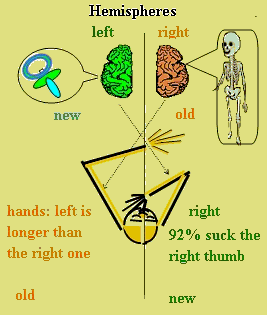|
Evolutionary
Theories of Asymmetrization of Organisms, Brain and Body
(II)

Single organs can have asymmetry on location, shape or
orientation. Paired organs can also have asymmetry on size
and functions.
Dominant
vs. subordinate— In a pair, one organ is dominant or
driving, and the other is subordinate or driven.
Typically, the dominant organ has larger bones and muscles,
and it fulfills its functions better (and thus is
preferred). Sometimes the organs are identical; in the case
of hands, this is ambidexterity.
Usually dominance is related to an organ. However if organ
has many functions, they can have different direction and
extent of dominance. For example, a person can be strongly
right handed on writing, slightly left handed on throwing
things and ambidextrous on another function.
Therefore
a function (not an organ as usually considered) is
the smallest element of asymmetry. Function is the only
level of asymmetry that has “pure” form of dominance.
Lateral
asymmetrization
goes from “bottom to top” (function
®
organ
®
organism
®
population).
The organ, organism and population are mosaics, i.e.
the asymmetry of an organ consists of a vector sum of
the asymmetry of its different functions. Asymmetry of the
organism is again the sum of the organs’ asymmetries.
Asymmetry of a population is the asymmetry of the ratio,
variance and lateral dimorphism of subpopulations of
asymmetric organisms (left and right handed).
Asymmetrization
is not especially-human phenomenon, but general
evolutionary phenomenon inherent to all live systems.
Therefore all attempts to explain
brain asymmetry as
a unique human feature (speech, right handedness, and
self-consciousness) and also as pathology or birth defect
need to be abandoned.
Brain
For the brain the most ancient asymmetry is cortex –
subcortex, then forehead – back of the head. The lateral
asymmetry is the youngest.
Functions
controlled by an operative hemisphere should be evolutionary
“younger” than functions controlled by a conservative
hemisphere.
In the left
hemisphere are located: perception of meaning and
reconstruction of speech, writing, self-awareness, fine
motor control of the fingers of both hands, logical,
analytical, abstract thinking, arithmetical calculation,
musical composition, color range, positive emotions. It
understands well time, verbs, is capable of false
statements. To the right hemisphere belong spatial-visual
capacities, intuition, music, speech intonation, coarse
movement of all extremities, integral perception, negative
emotions, humor. It understands little of verbs, abstract
terms (health, spite, joy, religion), and is not capable of
false statements.
The evolutionary
“age” of some other functions is not so obvious. For
example, emotions: negative-positive, understanding,
spatial-temporal, noun-verb, statements, true-false. Both in
phylogeny and in ontogeny the first appear earlier than the
second. In newborns crying precedes smiling, in kittens
plaintive whining, purring, in puppies whimpers begin three
months earlier than tail wagging. Moreover, with the
functional suppression of the brain negative emotions
disappear in the latter and are established in the first. If
one thinks of the thinking and vocabulary of child (or of
savages), then it is easy to be convinced that the
understanding of space is simpler than that of time, nouns
are simpler than verbs, true statements simpler than the
lie. The first words of a child are nouns, slyness and lies
appear later, orientation in space also occurs earlier than
in time. Color range also obviously can be considered as an
evolutionarily young acquisition. The characters of the
“Iliad” and “Odyssey” made use of a very narrow range of
colors.
Analysis of the
specialization of the hemispheres makes it possible to
conclude that left hemisphere should be considered an
operative subsystem, and right hemisphere—a
conservative one. The new information from the
environment goes first to
the left
hemisphere then to the
right
hemisphere:
| |
LH RH |
|
Environment |
 |
[The Evolutionary Theory of
Sex (ETS): the information from the environment
goes first to the males then to the females:
environment →
male sex →
female sex ]
Asymmetrization
along the axis “left – right” according to the new theory
occurs in time, so the left hemisphere is a
“vanguard” (as, already in the future) and right hemisphere
is a “rear-guard” (yet in the past).
“Age”
principle
of localization of centers in hemispheres. Centers for the
administration of new functions first appear in
the left hemisphere. After verification they are
translocated (get transferred) into the right
hemisphere.
[ETS: new genes appear in the male genome, stay there for
many generations, and after verification get transferred to
females]
In the Phylogeny of any function it is possible to
allocate three forms of localization of its center. Young
(new) functions are located only in the left hemisphere
(socio-cultural). Mature functions—(most functions
that have already been verified) are located both in the
left (later “versions”) and in the right (earlier
“versions”) hemisphere. Old functions that are
already lost by left hemisphere are located only in the
right hemisphere (biological).
Under the new theory the left hemisphere is social,
ontogenetic (phenotypical) therefore at an embryo it is
almost empty (and gets filled after birth). Right hemisphere
is biological, phylogenetic (genotypical), and therefore at
an embryo it is full of the old information. After birth,
sooner or later, the left hemisphere will inevitably catch
up with the right one and will surpass it. So, at some point
the translocation should occur— the right hemisphere newborn
should become the left hemisphere child. In the Ontogeny
there can be, basically, three translocations. The
first—postnatal—from right hemispheric embryo to left
hemispheric child (totally, on all functions). The
second—transition of a separate function from a child left
hemisphereness to adult right hemisphereness. And the
third—at loss of a function, in the opposite direction: from
adult right hemisphereness to senile involution (symmetry).
If the function undergoes reduction, there will be no
asymmetry, an example—sense of smell at men (by 80 years 85
% of nervous fibers will atrophy!).
Translocation—the
transition of function domination from one hemisphere into
another.
Phase
of function evolution determines which hemisphere will
dominate.
| |
Stages of
Phylogeny |
Translocation |
Dominates |
|
5 |
stable,
symmetry,
character φ
is absent |
 |
Better
search |
LH |
|
4 |
evolution,
asymmetry,
character φ
is eliminated |
Information
quantity |
RH |
|
3 |
stable,
symmetry,
character φ
is present |
Perfection |
|
2 |
evolution,
asymmetry,
character φ
is created |
Information
quantity |
LH |
|
1 |
stable,
symmetry,
character φ
is absent |
Better
search |
In stable phase of evolution (1) when the function is
absent, and the search is more important, the left
hemisphere responsible for the search will dominate.
In the phase of evolution (2), the left hemisphere
will dominate since only the left hemisphere has the
information about the newborn function.
In stable phase (3), when the information was transferred
into the right hemisphere but is still retained in
the left one, the right hemisphere (fast and more
flawless) will dominate.
In the phase of elimination or degradation of a function
(4), the right hemisphere will dominate since it
still has the information about the function.
And in stable phase of evolution (5) when the function is
lost, the left hemisphere starts dominating again.
Asymmetrization of the brain leads to two types of
dominance: left hemisphere (LH) and right hemisphere (RH).
Vast majority of humans (99%) have left hemisphere
dominance. Theory interprets hemisphere dominance as an
analogy to a genotype; the child is born with certain type
of dominance.
The right hemisphere should control embryogenesis
(old system) as a whole (morphology: a skull, a skeleton).
And, operated by the right hemisphere, the left part of a
body, should be larger, than the right one! The fetus has a
few new attributes and the left hemisphere (social,
according to the theory) is almost empty. One of such
attributes—a sucking reflex (analogue and almost the
coeval of a placenta). As is known, the fetus in a womb of
mother sucks the big finger. So, it should be the finger of
the right hand operated by the left hemisphere. In an
ultrasound study of fetal thumb sucking, it was found that
about 90% of fetuses above 15 weeks gestational age suck
their right thumb predominantly (Hepper, e.a., 1991). The factors producing manual asymmetries in early fetal life
remain unknown (Michel, 1983).

◄ The
evolution of Asymmetry (I)
Asymmetry of paired organs, hands (III)
► Questions
Predictions
|